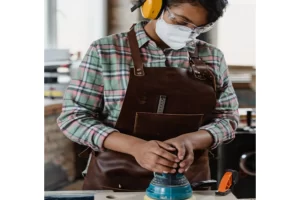Design trends are challenging for drywall repair work to provide building owners with surfaces that are aesthetically pleasing to the eye. Increased lighting that falls on a plasterboard surface can highlight even minor surface variations and imperfections in drywall repair . Thus, a need to know the relevant things before finishing the drywall arises.
A drywall is a fragile layer made from a sum poured between layers of heavy paper. They commonly appear in walls and ceilings due to their easy-to-apply application. This drywall technique also includes building frames, shaping them, and cutting them to fit in different places like doors and windows. After cutting and measuring, Drywall finishing or Drywall taping is complete. Technicians prepare drywall and paint it with joint drywall tape, which makes a smooth surface. This whole process is known as Drywall Finishing.
Architects, general contractors, and building owners often expect more drywall work than a subcontractor can provide with conventionally finished drywall surfaces. Consider using USG conventional or veneer plaster systems for high-value spaces and owners with high expectations.
Conventional plastering systems are the best choice for achieving a uniform, monolithic, smooth surface without defects. USG veneer plaster systems offer a more monolithic surface with an improved appearance than conventionally finished plasterboard surfaces.
A common misconception about drywall finishing is that joint finishing compounds should be applied flush or flat to the surface to cover drywall joints, fasteners, and trim. This procedure does not cover the panel adequately and increases the likelihood that joints and fasteners will penetrate the decorated finish.
A proper conventionally finished plasterboard surface is not truly monolithic. Applying grout in stepped curves over joints, fasteners, and moldings is the best method to minimize their appearance.
Depending on:
This practice aims to help specification writers and architects more accurately describe wall and ceiling finishes before applying paint and other wallpaper, and encourage competitive bidding of appropriately finished surfaces. Note that the chosen finish level from this document clearly defines the work processes to be completed by the drywall contractor but does not guarantee the visual result.
Consider creating a “ drywall install plan ” where the most critically illuminated surfaces or surfaces most prominently exposed within the building space receive the highest level of finish. Other surfaces may receive lower finish levels depending on lighting exposure conditions and expectations.

The recommended finish level for plasterboard surfaces varies depending on their location in the structure, the type of paint applied, the level of plasterboard finish achieved before final decoration, and the type of lighting incident on the surface.
Selecting and using a level 5 paint system in combination with a level 5 drywall finish is the most effective method to minimize joint and fastener photo-shooting and provide the most uniform finish.
In project specifications, emphasize the requirement for proper environmental conditions during and after drywall hanging, finishing, and decorating. Uncontrolled conditions and environmental fluctuations are the leading cause of many finish appearance problems and the primary cause of joint cracks and ridges. This area is where joint drywall tape comes in handy.
Ideally, the interior of the building should be weatherproof, and the surrounding conditions should approximate normal living conditions.
For timber-framed structures, the moisture content of the frame elements should be allowed to adjust as much as possible to the level that the components will reach in service before starting the application of plasterboard.
Textured finish products are excellent for masking minor imperfections and diffusing the light across wall and ceiling surfaces. The range can create various visually appealing finishes, from subtle to heavy, with final texturing products using brushes, patterning devices, rollers, squeegees, and finishing knives.
Proper use of control joints will accommodate and act on the stresses within the gypsum membranes, minimizing the possibility of joint cracks and ridges.
The best thing about hiring a drywall repair service is that people get to work hands-on. Many people like to experience the process of building with their hands. Drywall work makes it a great place to try on your building skills. Drywall professionals are in high order, especially in ceiling sheetrock and drywall repair services.
In some cases, drywall finishing can be an art rather than a science – give a good drywaller complete freedom, and they will provide you with a room with clean lines and smooth corners.
Read More